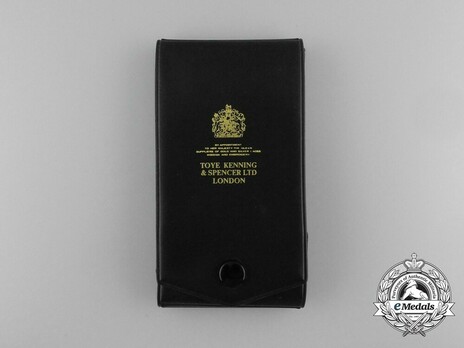Toye, Kenning And Spencer
LAST UPDATED:

Attributes
History
The Toyes were Hugenot refugees that arrived in London, England in 1865 disguised as cattle dealers. The Toye family settled in Hope Town (present day Bethnal Green). Guillaume Henri Toye and his family began weaving velvet, silk, gold, and silver laces for the gentry. The family gained popularity with military clientele. In 1793, Charles, the great-grandson of Guillaume, sets up a factory in Camden Town to produce gold and silver threads, military accoutrements, lace and cord. In 1835, William Toye formally established the firm at a larger premises on George Street in Hope Town.
In 1855, the eldest son of William Toye, also by the name of William, invented a gas operated power loom, which allowed for quicker production of goods and pushed the company to further success. That same year the company built a new, modern building at Old Fort Road in Hope Town. In 1860, the company of George Kenning was established and William Toye expanded to different types of weaving, including ribbon weaving. Toye also opened a retail store in London.
Just a year later, in 1861, Toye secretly supplied uniforms and accoutrements for both sides during the American Civil War, which sparked controversy. In 1889, Toye produced khaki uniforms for the British military because of the technological advancement of cordite, a smokeless gunpowder. The lack of smoke caused by gunpowder made it easy for enemies to spot the British in their bright uniforms and thus Toye produced khaki uniforms to assist in camouflaging soldiers.
In 1898, the company opened a premises at 57 Theobalds Road and Red Lion Square in London. In 1903, Hubert Toye joined the company. In 1909, the company registered as a firm and became Toye & Co. A year later, William Toye Senior died and his sons William, Frederick, Herbert and Timothy J. Mister become partners in the business. When World War I began in 1914, Frederick Toye enlisted for overseas service. A large number of women were employed by the company during the war. The company was hit especially hard during the First World War and almost went bankrupt.
In 1918, the men who served and survived the war returned home and back to work at the company, but the company did not regain stability until 1921. In 1930, the company enlarged and rebuilt the factory at Red Lion Square in London, but was hit hard by the Depression. The coronation of King George VI and Queen Elizabeth took place in 1937 and Toye was warranted to produce regalia, banners, robes and insignia for the event. Workers at the company worked day and night for six months in preparation for the event. The cushion that the royal crowns were carried on were made by the company.
World War II began in 1939 and sent the company on another spiral. J.W.A. Toye joined the Royal Air Force and many men at the company also enlisted in overseas service. J.W.A. Toye was captured by enemy forces in 1942 and died of malaria during a march to a prisoner of war camp. 1945 marked the end of World War II, but the beginning of another tumultuous period for the company. The company faced a massive backlog and members who served during the war took up to three years to return to England.
In 1947 George Kenning acquires Spencer & Co. In 1949, Hettie Toye was elected to the Board after 30 years with the company. This was a big move for the company as not many other firms elected women to such high positions. King George VI died in 1952 and the company made banners and regalia for the ceremony. In 1956, Toye & Co acquired Kenning and Spencer & Co, becoming Toye, Kenning and Spencer.

This makerMark is not associated with any groups yet.
This maker currently has no products.


Scroll Top